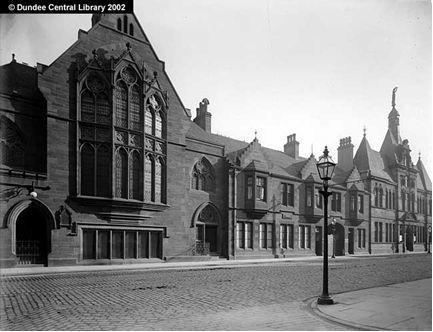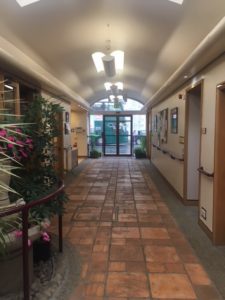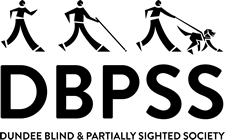Our History

John Milton (Poet 1608-74) In 1652 Milton’s gruelling workload had cost him his eyesight, but he still went on to write his masterpiece Paradise Lost.
Also, from his sonnet On His Blindness comes the memorable quote:
“They also serve who only stand and wait” in which he was referring to people who are blind.
Henry Fawcett (1833-84) lost his sight in a shooting accident in 1858. In 1863 he became Professor of Political Economy in Cambridge. Liberal MP (1865) and Postmaster General from 1880. He introduced Postal Orders, Parcel Post and 6d Telegrams.
William Moon (1818-1894) Partially blind from the age of four, totally blind in 1840 and then began to teach blind children. Dissatisfied with embossed type of system and developed his own system based on Roman capitals.
Dundee Mission to the Out-Door Blind was formed by Mr John Galt, 18 Speeds Terrace, Tait’s Lane, Hawkhill, Dundee in June 1879. Enquiries at that time in Dundee and Lochee revealed 100 people who were blind and “almost unknown and uncared for.”
An extract of the Tenth Annual Report of the Mission states that: –
“Such a painful revelation was cause sufficient for taking immediate steps towards establishing a Mission on their behalf, and on lines similar to that of other Missions in Scotland already at work on behalf of the hapless thousands then, and still, outside the benefits of asylums and institutions, familiarly known by the name of “out-Door Blind.”
Mr Galt was Superintendent of the Mission for thirty years, during which time he “laboured incessantly in the interests of the Blind committed to the Mission’s care”. Mr Galt was very highly regarded by both those people for whom the Mission cared and by the Board of Directors. He retired in 1909.
Ten years after its formation, the Mission had a total of 359 blind people, sixty of whom had their sight restored (at Glasgow Eye Infirmary by operation or treatment paid for by the Mission) and were able to earn their own living: –
This fact alone is more than sufficient to prove the value and necessity of our Mission, and more than repays for all the labour and outlay put together. (Annual Report 1899)

In the same year it was reported that eighty people learned to read by Moon’s raised type (embossed print based on Roman capitals) and a library containing over 300 volumes costing £70 was established. This facility was used extensively by the Mission’s members and employees of “the Institution” (Workshops for the Blind, Magdalen Yard Road, now part of Dovetail Enterprises, Dunsinane Avenue, Dundee)
In the first ten years, £2,037 was raised. The sum of £280 from “Sabbath Schools, Bible Classes and Dundee Boys’ and Girls’ Religious Association” gave particular satisfaction because of the interest and care the younger generation were showing to their less fortunate elders.
In 1881 “a few lady friends” of the Mission established a “Mission Collecting Cards” fundraising scheme and in November 1901, the Ladies Auxiliary was formed “which proved to be one of the greatest assets the Mission has”. (Annual Report 1929)
In 1912 the Home Industries activity of the Mission originated because of a donation of £10 from the Rev. Hugh C. R. Cunnynghame M.A., who wished “some pastime occupation” taught to the home-based members.
In 1921 the Mission celebrated its Golden Jubilee. During this year, two lady Hometeachers were appointed. These ladies carried out 2,608 home visits – the City being divided into east and west sectors. The duties of these Hometeachers included reading the Scriptures, teaching Moon and Braille, providing members with work (as per Home Industries Scheme), preparing, finishing, pressing and pricing the work and any other duties that would improve the quality of life of the Mission Member. During this same period, a legacy from Sir James Duncan of Coupar Angus and Kinnettles enabled the Directors to make up the poorest member’s income to 15/- a week.
A deficit of £65 13s 6d for the same year was reported, but, since the Blind Persons Act of 1920, the Mission was pleased to say that the Local Authorities had been very helpful in agreeing to pay any deficit that might occur.
The Mission worked closely with other bodies. For example, if a child was discovered to be blind, Royal Dundee Institution for the Blind was contacted which, in turn, informed the Education Authority. The Town Council issued free wireless licences and free car passes (now bus passes).
In its earliest days, religion played an important role in the Mission’s work. The Scriptures were included in the 300 original volumes of the Mission’s library as previously mentioned. In 1879 Mr Galt stated: –
 Our whole world breathes of religion and is maintained throughout in a religious spirit. Our human services towards them (members of the Mission) preach as no words of mine could possibly do.
Our whole world breathes of religion and is maintained throughout in a religious spirit. Our human services towards them (members of the Mission) preach as no words of mine could possibly do.
The Mission would appear to have been administered from Mr Galt’s address until 1893, when it was then based at 26 Castle Street and remained there until moving to Caird Rest, 172 Nethergate, Dundee in 1927. In 1951 the Mission moved again, this time to 39 St Andrews Street until June 1994. The next move was then to 35 Yeaman Shore, Dundee until the move to the present purpose designed building at 10-12 Ward Road in 2000.
In 1918 the Mission was renamed Dundee and Lochee Mission to the Out-Door Blind and this name was retained until 1936 when it reverted to its original name. In 1965, the name was changed to Dundee Society for the Welfare of the Blind, in 1992 to Dundee Society for Visually Impaired People and to our present name, Dundee Blind and Partially Sighted Society, in 2003.
At present, the Society has around 200 Members from across Dundee, Angus and Fife . The CEO, along with an excellent staff team and the Board of Directors, continue the work started in 1879 by Dundee Mission for the Out-Door Blind. We hope Mr John Galt would approve.
